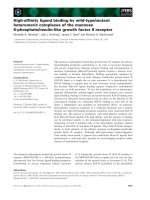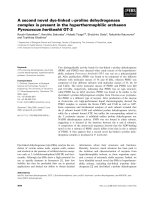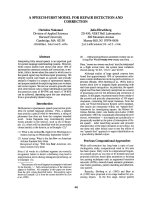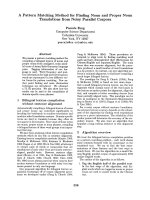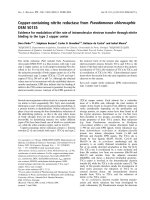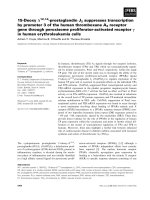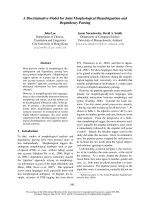Báo cáo khoa học: "A rare tumoral combination, synchronous lung adenocarcinoma and mantle cell lymphoma of the pleura" docx
Bạn đang xem bản rút gọn của tài liệu. Xem và tải ngay bản đầy đủ của tài liệu tại đây (568.04 KB, 5 trang )
BioMed Central
Page 1 of 5
(page number not for citation purposes)
World Journal of Surgical Oncology
Open Access
Case report
A rare tumoral combination, synchronous lung adenocarcinoma
and mantle cell lymphoma of the pleura
Dimitrios Hatzibougias
1
, Mattheos Bobos
1
, Georgia Karayannopoulou
1
,
Georgios Karkavelas
1
, Georgios T Karapanagiotidis
2
,
Christophoros N Foroulis*
2
and Ioannis Kostopoulos
1
Address:
1
Aristotle University of Thessaloniki Medical School, Department of Pathology, Thessaloniki, Greece and
2
Aristotle University of
Thessaloniki Medical School, AHEPA University Hospital, Department of Cardio-Thoracic Surgery, Thessaloniki, Greece
Email: Dimitrios Hatzibougias - ; Mattheos Bobos - ; Georgia Karayannopoulou - ;
Georgios Karkavelas - ; Georgios T Karapanagiotidis - ;
Christophoros N Foroulis* - ; Ioannis Kostopoulos -
* Corresponding author
Abstract
Background: Coexistence of adenocarcinoma and mantle cell lymphoma in the same or different
anatomical sites is extremely rare. We present a case of incidental discovery of primary lung
adenocarcinoma and mantle cell lymphoma involving the pleura, during an axillary thoracotomy
performed for a benign condition.
Case presentation: A 73-year old male underwent bullectomy and apical pleurectomy for
persistent pneumothorax. A bulla of the lung apex was resected en bloc with a scar-like lesion of
the lung, which was located in proximity with the bulla origin, by a wide wedge resection. Histologic
examination of the stripped-off parietal pleura and of the bullectomy specimen revealed the
synchronous occurrence of two distinct neoplasms, a lymphoma infiltrating the pleura and a
primary, early lung adenocarcinoma. Immunohistochemical and fluorescence in situ hybridization
assays were performed. The morphologic, immunophenotypic and genetic findings supported the
diagnosis of primary lung adenocarcinoma (papillary subtype) coexisting with a non-Hodgkin, B-cell
lineage, mantle cell lymphoma involving both, visceral and parietal pleura and without mediastinal
lymph node involvement. The neoplastic lymphoid cells showed the characteristic
immunophenotype of mantle cell lymphoma and the translocation t(11;14). The patient received 6
cycles of chemotherapy, while pulmonary function tests precluded further pulmonary parenchyma
resection (lobectomy) for his adenocarcinoma. The patient is alive and without clinical and
radiological findings of local recurrence or distant relapse from both tumors 14 months later.
Conclusion: This is the first reported case of a rare tumoral combination involving simultaneously
lung and pleura, emphasizing at the incidental discovery of the two coexisting neoplasms during a
procedure performed for a benign condition. Any tissue specimen resected during operations
performed for non-tumoral conditions should be routinely sent for pathologic examination.
Published: 29 December 2008
World Journal of Surgical Oncology 2008, 6:137 doi:10.1186/1477-7819-6-137
Received: 29 July 2008
Accepted: 29 December 2008
This article is available from: />© 2008 Hatzibougias et al; licensee BioMed Central Ltd.
This is an Open Access article distributed under the terms of the Creative Commons Attribution License ( />),
which permits unrestricted use, distribution, and reproduction in any medium, provided the original work is properly cited.
World Journal of Surgical Oncology 2008, 6:137 />Page 2 of 5
(page number not for citation purposes)
Background
Recent epidemiologic evidence suggest that lung cancer is
the leading cause of cancer mortality in both sexes and is
distinguished according to histopathologic features in two
large categories, the small cell lung carcinoma (SCLC) and
the non-small cell lung carcinoma (NSCLC) [1]. The most
common type of the latter is lung adenocarcinoma which
is usually presented as single or multiple poorly circum-
scribed peripheral lung lesions [2]. Papillary adenocarci-
noma is a rare histopathologic subtype of lung
adenocarcinoma which is characterized by predominantly
papillary structures that replaces the underlying lung
parenchyma and has been stated to be associated with
poorer prognosis [3,4].
Mantle cell lymphoma (MCL) is a distinct type of B-cell
non-Hodgkin lymphoma characterized by
t(11;14)(q13;q32) and Cyclin D1 over-expression, com-
prising from 3% to 10% of all non-Hodgkin's lymphomas
[5,6]. The affected patients are mainly middle-aged or
older and they are often presented with advanced stage
disease (Stages III-IV), frequently involving multiple
extranodal sites [7].
Synchronous occurrence of lung adenocarcinoma and
malignant lymphoma of the pleura is not reported until
today and we report the unique case of a lung adenocarci-
noma coexisting with a mantle cell lymphoma of the
pleura, which were incidentally discovered during an
operation for pneumothorax.
Case presentation
A 73-year old man, heavy smoker, with history of chronic
obstructive pulmonary disease, coronary artery disease
and HBV infection was admitted to a district hospital
because of dyspnea and fever (38–38.5°C). Clinical and
radiologic findings revealed spontaneous pneumothorax
on the right side, which was initially managed by chest
tube drainage. Due to persistent for more than 10 days air
leak through the chest tube, he was referred to the depart-
ment of Cardiothoracic Surgery at AHEPA University Hos-
pital. CT scan imaging of the thorax showed diffuse
emphysema, surgical subcutaneous emphysema on the
right side as the result of previous chest tube drainage, a
scar-like lesion that was located in the periphery of the
posterior segment of the right upper lobe (Fig. 1a) and
thickening of parietal pleura adjacent to the lung scar (Fig.
1b). Because of the prolonged air leak, the patient under-
went apical bullectomy and apical parietal pleura resec-
tion to achieve pleurodesis through an axillary
thoracotomy. The scar-like lesion of the lung was resected
en bloc with the bullectomy specimen by a wide wedge
resection of lung parenchyma.
Pathological findings and immunohistochemistry
On macroscopic examination of the bullectomy speci-
men, a solid yellowish nodular lesion measuring up to 1.6
cm was found. Close to that lesion many cystic spaces
were found.
The histologic examination of hematoxylin-eosin-stained
sections revealed an adenocarcinoma composed of atypi-
Preoperative chest CT scanFigure 1
Preoperative chest CT scan. (A) Diffuse emphysematous changes of the right upper lobe, surgical subcutaneous emphy-
sema and a scar-like lesion located in the periphery of the posterior segment of the right upper lobe (arrow). (B) Thickening of
the parietal pleura in proximity to the scar-like lesion (arrow).
World Journal of Surgical Oncology 2008, 6:137 />Page 3 of 5
(page number not for citation purposes)
Lung adenocarcinoma with micropapillary pattern (A, E & H)Figure 2
Lung adenocarcinoma with micropapillary pattern (A, E & H). Neoplastic ducts showing strong nuclear staining for
TTF-1 (B) and cytokeratin 7 (C). Mantle cell lymphoma with diffuse infiltration of the pleura (D, E & H). Lymphomatous cells,
positive for CD5 (E) and cyclin D1 (F). FISH method using the LSI IGH/CCND1 dual color, dual fusion translocation probe:
nucleus of neoplastic lymphoid cell with t(11;14) displaying the signal pattern 2 yellow (fusion translocation signals), 2 red
(CCND1 gene) and 2 green (IGH gene) (G).
World Journal of Surgical Oncology 2008, 6:137 />Page 4 of 5
(page number not for citation purposes)
cal adenoid formations showing intraluminal papillary
projections, some of them detached (Fig. 2a). The tumor
cells were tall-cylindrical, with pale eosinophilic cyto-
plasm and polymorphic nuclei with or without promi-
nent nucleoli. The mitotic activity was low (< 2 mitoses
per 10 HPF). There were also foci of necrosis, hyalinosis
and ossification. Immunohistochemical stains showed
the following tumor-cell immunophenotype: TTF-1(+)
(Novocastra, UK), CK7(+) (Dako, DK), CK20(+) (Dako),
EGFR(+) (Zymed, USA), p53(+) (Dako), Cyclin D1(+)
(Spring, USA), Calretinin(-) (Dako) (Fig. 2b, 2c). The
adjacent lung parenchyma showed serious emphysematic
changes.
The visceral pleura proximal to the adenocarcinoma and
the separately sent to the laboratory specimen of stripped-
off parietal pleura tissue showed a band-like diffuse infil-
tration from neoplastic lymphoid cells (Fig. 2d). The lym-
phoid cells were medium-sized, with rounded or angular
nuclei and with one or more indistinct nucleoli. Focally
there was a nodular pattern of growth. The immunophe-
notype of the lymphoma cells was the following:
CD20(+) (Dako), CD45RA(+) (Dako), CD5(+) (Novo-
castra), Cyclin D1(+) (Spring), CD45RO(-) (Dako),
CD3(-) (Novocastra), CD23(-) (Novocastra), EGFR(-),
Calretinin(-) (Fig. 2e, 2f). The CD23 immunostain
revealed a residual network of dendritic cells, referring to
infiltration of preexisting germinal centers.
Fluorescence in situ hybridization (FISH)
Metaphase FISH analysis was also performed using EGFR/
CEP7, CCND1/CEP11 dual color LSI probes and LSI IGH/
CCND1 dual color, dual fusion translocation probe (all
from Abbott Molecular, USA). Gains of EGFR and
CCND1 genes were observed in the adenocarcinoma. On
the other hand, in MCL the characteristic translocation
between CCND1 gene on chromosome 11 and IGH gene
on chromosome 14 [t(11;14)] was found (Fig. 2g). In
addition CCND1 gene was amplified, whereas EGFR gene
was on normal range.
The morphologic, immunophenotypic and genetic find-
ings support the diagnosis of primary lung adenocarci-
noma (papillary subtype) coexisting with a non-Hodgkin,
B-cell lineage, mantle cell lymphoma involving both, vis-
ceral and parietal pleura and without mediastinal lymph
node involvement.
Follow-up
The patient received 6 cycles of chemotherapy (Endoxan,
Farmorubicin and Vincristine) and his clinical status, 14
months after the diagnosis is good, without any evidence
of local recurrence, metastatic disease or lymph node
involvement, according to the follow-up CT scan imaging
of thorax, abdomen and brain.
Discussion
Synchronous occurrence of lung adenocarcinoma and
mantle cell lymphoma of the pleura is not reported in the
medical literature until today. Extensive search of the lit-
erature revealed few cases with coexistence of different
types of lung carcinomas and malignant lymphomas.
Chanel et al. described a synchronous pulmonary adeno-
carcinoma and extranodal marginal zone lymphoma of
MALT type [8]. Rothenburger et al. reported a non-Hodg-
kin's lymphoma coexisting with a NSCLC, whereas Rubi-
ales et al. described the synchronous occurrence of a
small-cell lung cancer and a Hodgkin lymphoma [9,10].
Coexistence of adenocarcinoma and mantle cell lym-
phoma in other anatomical sites, such as the large bowel,
has been reported in the past. In total we found four cases
concerning colonic involvement. Hopster et al, described
2 foci of colonic adenocarcinoma associated with MCL
[11]. Kanehira et al., presented also 2 cases of invasive ade-
nocarcinoma of the colon coexisting with early MCL [12].
The fourth case reported by Padmanabhan et al, con-
cerned the synchronous presence of adenocarcinoma
located in the cecum and MCL involving the colon, the
terminal ileum and the regional lymph nodes [13].
Another case of synchronous existence of nodal mantle
cell lymphoma and metastatic in mediastinal lymph
nodes small cell lung carcinoma was reported by Kampal-
ath et al [14].
Lung adenocarcinoma usually arises from peripheral
small bronchi and may be associated with a lung scar (scar
adenocarcinoma). It is composed of malignant glandular
epithelium which may vary in degree of differentiation
from tumor to tumor. Well differentiated tumors may
form distinct glands, while others may vary from forming
papillary structures to solid tumors without any gland for-
mation. The prognosis depends on the histologic type,
clinical stage, and the patient's performance status. A
micropapillary pattern is a predictor of poor prognosis
[3,15]. The presence of this component should alert the
clinician to search more carefully for clinically "silent"
metastases.
MCL is a neoplasm of monomorphous small to medium-
sized B lymphocytes with irregular nuclei, which resemble
the cleaved cells (centrocytes) of germinal centers. Neo-
plastic transformed cells (centroblasts or immunoblasts)
are absent. Tumor cells are typically CD5(+) and CD23(-
). The vast majority overexpresses Cyclin D1. Vega et al, in
their review of 34 patients with lymphoma involving the
pleura that was detected by pleural biopsy, found only 1
MCL among the 34 cases [16]. The most frequent type in
their series was diffuse large B-cell lymphoma, followed
by follicular lymphoma. The histologic pattern of MCL
may be diffuse, nodular, or mantle zone, or a combina-
World Journal of Surgical Oncology 2008, 6:137 />Page 5 of 5
(page number not for citation purposes)
tion of the three patterns of growth. Some reports indicate
a better prognosis for cases with a mantle zone pattern.
Despite the small size and bland appearance of these cells,
there is often more mitotic activity than in other histolog-
ically low-grade lymphomas. Diffuse forms and those
which show high mitotic rates (> 20 HPF in diffuse and >
10 HPF in follicular) have a worse prognosis.
We report a unique case of coexistence of lung adenocar-
cinoma and mantle cell lymphoma of the pleura. The
patient was admitted to the hospital due to persistent air
leak from chest tube after an episode of spontaneous sec-
ondary pneumothorax, with no other specific clinical
signs, and both tumors were incidentally identified. Poor
results of pulmonary function tests and the coexistence of
mantle cell lymphoma precluded the patient from further
surgical treatment (lobectomy) for his early lung adeno-
carcinoma.
Conclusion
The therapeutic management of such a combination of
tumors requires separate consideration of their biologic
behavior, the performance status of each patient individ-
ually and the estimated morbidity related to surgery and/
or chemo-radiotherapy. We should note that any tissue
resected during any non-oncologic intrathoracic proce-
dure should be collected separately and sent for patho-
logic examination, especially in older people. Any scar
detected in the lung should also resected during an
intrathoracic procedure performed for benign disease, if
do not require a major operation and do not add signifi-
cant risk for the patient.
Abbreviations
SCLC: squamous cell lung cancer; NSCLC: non small cell
lung cancer; MCL: mantle cell lymphoma; HBV: hepatitis
B virus; CT: computed tomography; FISH: fluorescence in
situ hybridization; HPF: high power field; MALT: mucosa-
associated lymphoid tissue.
Consent
Written informed consent was obtained from the patient
for publication of this case report and any accompanying
images. A copy of the written consent is available for
review by the Editor-in-Chief of this journal.
Competing interests
The authors declare that they have no competing interests.
Authors' contributions
DH carried out pathology examination, immunohisto-
chemistry and drafted the manuscript. MB carried out
immunohistochemistry and FISH assays and drafted the
manuscript. Georgia Karayannopoulou carried out
pathology examination, immunohistochemistry and
FISH assays, has drafted the manuscript and has contrib-
uted to the interpretation of the results. Georgios Karkave-
las has given final approval of the version to be published.
GTK has assisted the surgeon, did the collection of the
data and have been involved in the design and drafting of
the manuscript. CNF has performed the operation and
has critically revised the initial draft. IK carried out pathol-
ogy examination, immunohistochemistry and FISH
assays, has critically revised the initial draft and has given
final approval of the version to be published
References
1. Parkin M, Tyczynski JE, Boffetta P, Samet J, Shields J, Caporaso N:
Lung cancer epidemiology and etiology. In World Health Organ-
ization Classification of Tumours. Pathology and Genetics of Tumors of the
Lung, Pleura, Thymus and Heart Edited by: Travis WD, Brambilla E,
Muller-Hermelink HK, Harris CC. Lyon: IARC Press; 2005:12-15.
2. Madri JA, Carter D: Scar cancers of the lung. Origin and signif-
icance. Hum Pathol 1984, 15:625-631.
3. Amin MB, Tamboli P, Merchant SH, Ordóñez NG, Ro J, Ayala AG, Ro
JY: Micropapillary component in lung adenocarcinoma: a dis-
tinctive histologic feature with possible prognostic signifi-
cance. Am J Surg Pathol 2002, 26:358-364.
4. Miyoshi T, Satoh Y, Okumura S, Nakagawa K, Shirakusa T, Tsuchiya
E, Ishikawa Y: Early-stage lung adenocarcinomas with a micro-
papillary pattern, a distinct pathologic marker for a signifi-
cantly poor prognosis. Am J Surg Pathol 2002, 27:101-109.
5. Barista I, Romaguera JE, Cabanillas F: Mantle cell lymphoma. Lan-
cet Oncol 2001, 2:141-148.
6. de Boer CJ, Schuuring E, Dreef E, Peters G, Bartek J, Kluin PM, van
Krieken JH: Cyclin D1 protein analysis in the diagnosis of man-
tle cell lymphoma. Blood 1995, 86:2715-2723.
7. Pittaluga S, Wlodarska I, Stul MS, Thomas J, Verhoef G, Cassiman JJ,
Berghe H Van den, de Wolf-Peeters C: Mantle cell lymphoma. A
clinicopathological study of 55 cases. Histopathology 1995,
26:17-24.
8. Chanel S, Burke L, Fiche M, Molina T, Lerochais JP, Icard P, Diebold J,
Galateau-Sallé F: Synchronous pulmonary adenocarcinoma
and extranodal marginal zone/low- grade B-cell lymphoma
of MALT type. Hum Pathol 2001, 32:129-132.
9. Rothenburger M, Semik M, Hoffmeier A, Baba H, Kamanabrou D,
Roos N, Schmidt C, Scheld HH: Coexistence of non-Hodgkin's
lymphoma and non-small cell lung carcinoma: diagnosis and
treatment. Thorac Cardiovasc Surg 2002, 50:59-61.
10. Rubiales AS, Martinez G, Aller JL, Roig V, del Valle ML: Synchronous
diagnosis of small-cell lung cancer and Hodgkin lymphoma.
An Med Interna 2006, 23:301-302.
11. Hopster D, Smith PA, Nash JR, Elders K, Poston GJ: Synchronous
multiple lymphomatous polyposis and adenocarcinomas of
the large bowel. Postgrad Med J 1995, 71:443.
12. Kanehira K, Braylan RC, Lauwers GY: Early phase of mantle cell
lymphoma: a report of 2 cases associated with advanced
colonic adenocarcinoma. Mod Pathol 2001, 14:811-817.
13. Padmanabhan V, Trainer TD: Synchronous adenocarcinomas
and mantle cell lymphoma of the colon. Arch Pathol Lab Med
2003, 127:E64-66.
14. Kampalath B, Abed N, Chitambar CR, Vantuinen P, Chakrabarty G,
Hanson G, Rao RN, Shidham VB, Chang CC: Mantle cell lym-
phoma in lymph nodes with metastatic small cell carcinoma
of lung: a diagnostic and treatment dilemma. Leuk Lymphoma
2004, 45:409-414.
15. Tsutsumida H, Nomoto M, Goto M, Kitajima S, Kubota I, Hirotsu Y,
Wakimoto J, Hollingsworth MA, Yonezawa S: A micropapillary
pattern is predictive of a poor prognosis in lung adenocarci-
noma, and reduced surfactant apoprotein An expression in
the micropapillary pattern is an excellent indicator of a poor
prognosis. Mod Pathol 2007, 20:638-647.
16. Vega F, Padula A, Valbuena JR, Stancu M, Jones D, Medeiros LJ: Lym-
phomas involving the pleura: A clinicopathological study of
43 cases diagnosed by pleural biopsy. Arch Pathol Lab Med 2006,
130:1497-1502.
